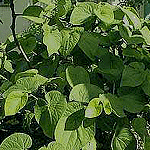|
|
The Eclectic Physician
Medicinal Herb Monographs
Kava Kava
Botanical Name
Piper methysticum
|

Piper methysticum
(Kava) |
The information on this page compiled by
Beth Burch N.D.
Index
(click on the keywords)
Introduction
Kava-kava has a long history of use in Polynesia, probably dating back
2500-3000 years. It is an integral part of rituals in the South Sea Islands.
King’s American Dispensatory recommends it for neuralgia, toothache and
earache, dysuria and dysmenorrhea. Weiss’ Herbal Medicine lists it for
its sedative and anesthetic effect on the bladder. Most recently it has
been studied for its anti-anxiety effects.
[ Back to the Index. ]
Description
-
Kava-kava is a shrub about 6 feet high, a native of the South Sea Islands.
It somewhat resembles bamboo in its growth and has alternate cordate leaves
with prominent veins. It has small slender spikes of flowers. The root
is the medicinal part.
[ Back to the Index. ]
Constituents
-
Kavalactones, including kavain, dihydrokavain, methysticin, dihydromethysticin,
yangonin, dimethoxyyangonin
[ Back to the Index. ]
Action/Effects
-
Sedative- seems to act on the limbic system, does not bind to specific
receptors (1)
-
Analgesic
[ Back to the Index. ]
Conditions used
for
-
Anxiety (2,3,4)
-
Menopausal symptoms (5)
-
Useful for urinary tract discomfort, menstrual cramps and neuralgia
[ Back to the Index. ]
Dosage
-
Dried extract or freeze-dried- amount to yield 45-70 mg of kavalactones
three times a day
-
Liquid extract- 1/4 teaspoon three times a day
[ Back to the Index. ]
Side Effects
-
Mild gastrointestinal upset
-
Nausea and headache with acute toxicity
-
Dermatitis with long term high doses
[ Back to the Index. ]
Contraindications
-
Endogenous depression
-
Allergy to kava
[ Back to the Index. ]
Interactions
with medications
-
Do not use with benzodiazipines, barbiturates, other sedatives, alcohol,
antidepressants or antipsychotic medications (6,7)
[ Back to the Index. ]
Use in
pregnancy & lactation
-
Do not use in pregnancy or lactation
[ Back to the Index. ]
References
1. Holm E et al, Studies on the profile of the neurophysiological
effects of D,L-kavaine: Cerebral sites of action and sleep-wakefulness
rhythm in animals, Arzneim-Forsch Drug Res 1991; 41:673-83
2. Piper methysticum (kava kava), Altern Med Rev 1998;3(6):458-60
3. Scherer J, Kava-kava extract in anxiety disorders: an outpatient
observational study, Adv Ther 1998;15(4):261-9
4. Volz HP et al, Kava-kava extract WS1490 versus placebo in anxiety
disorders-a randomized placebo-controlled 25-week outpatient trial, Pharmacolpsychiatry
1997;30(1):1-5
5. Warnecke G, Psychosomatic dysfunctions in the female climacteric:
Clinical effectiveness and tolerance of Kava extract WS1490, Fortschr Med
1991;109(4):119-22
6. Miller LG, Herbal medicinals: selected clinical considerations focusing
on known or potential drug-herb interactions, Arch Intern Med 1998;158(20):2200-11
7. Jamieson DD et al, Positive interaction of ethanol and kava resin
in mice, Clin Exp Pharmacol Physiol 1990;17(7):509-14
[ Back to the Index. ]
* The information presented in this web site is intended to inform and educate.
It is not intended replace a qualified medical practitioner to diagnose or treat medical conditions.
|
|

